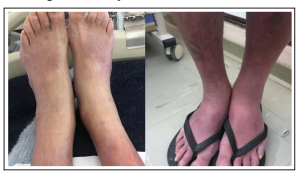Author(s): Inês Ângelo*, Joana Lopes Ferreira, Joaquim Peixoto and Martinho Fernandes
Autonomic dysfunction (AD) can manifest in Chronic liver disease (CLD), whose pathophysiological mechanism remains somewhat misunderstood. The following case reports a 57-year-old patient, hospitalized because of his decompensated CLD-ethanolic etiology-who started with an acrocyanosis condition in the lower limbs, after positional change to orthostatism. With other causes excluded, his blood pressure (BP) variation and his heart rate (HR) were analyzed. The latter allowed a diagnosis of Orthostatic Hypotension (OH) and Postural Orthostatic Tachycardia Syndrome (POTS), which can be frequently considered as manifestations of AD. There is a high percentage of CLD of ethanolic etiology patients that suffer from alterations in the autonomous nervous system caused by decreased function of baroreceptors to positional variations. This clinical case aims to exhibit an atypical presentation of two entities that characterize AD and may be present in these patients.
The AD is a condition with considerable impact on CLD, although pathophysiologically poorly understood. There may be factors inherent to the natural history of CLD and its treatment that can mask and/or make its diagnosis difficult. The subsequent case describes a rare presentation of acrocyanosis as a manifestation of AD in CLD.
It is presented the clinical case of a 57-year-old male patient, previously autonomous on everyday tasks, with a previous diagnosis of chronic ethanolism and CLD (Score Child-Pugh C; MELD score 24 points), hospitalized with ascites under tension requiring evacuatory paracentesis.
After clinical stabilization with a prediction of short-term hospital discharge, the patient develops acrocyanosis (symmetric, painless and persistent peripheral cyanosis) at the level of the lower limbs (LLs) about 10 seconds after the positional change from decubitus to orthostatism (Figure 1) Initially, it was considered, the hypothesis of peripheral vascular etiology (despite the symmetrically palpable peripheral pulses) or central vascular etiology. Complementary diagnostic tests were carried out, namely analytical evaluation with complete blood count, coagulation and biochemistry studies, as well as imaging tests such as echo-doppler of the MI‘s and abdomino-pelvic computed tomography angiography, which did not reveal any changes. After excluding other etiologies, the hypothesis of AD was investigated. As such, the variation of BP and HR in the change from decubitus to orthostatism was evaluated. Initially, a BP value of 107/67 mmHg and HR of 84 beats per minute (bpm) was recorded in the supine position. After 3 minutes of orthostatism, there was a drop in BP values to 85/50 mmHg, with a HR of 90 bpm. After 10 minutes of orthostatism, there was an increase in HR to 116 bpm, with no change in BP. The observed changes were interpreted in the context of OH and POTS

Figure 1: Lower Limbs Acrocyanosis after 10 Seconds of Orthostatism
It was found that more than 70% of patients with CLD of ethanolic etiology suffer from changes in the sympathetic and/ or parasympathetic nervous system. The OH and POTS are two entities that represent important manifestations of intolerance to orthostatism associated with AD. In regard to OH or postural hypotension, this corresponds to an excessive drop in BP within 3 minutes after switching to orthostatism (drop in systolic BP > 20 mmHg and/or diastolic BP > 10 mmHg) and represents one of the most frequent consequences of AD in CLD. Some of the most commonly described symptoms are blurred vision, fainting, dizziness, confusion, syncope or, in more extreme cases, seizure. These appear seconds to minutes after orthostatic change and regress rapidly. POTS (also called Postural Autonomic Tachycardia) is another manifestation of orthostatic intolerance. Despite the absence of universally accepted diagnostic criteria, the most frequently established definition corresponds to a HR ≥ 120 bpm or a ≥ 30 bpm increase in positional change, after 10 minutes in orthostatism, with no change in BP. Symptoms may be similar to those seen in OH. Chest pain, palpitations, and sweating may also be present. There are documented cases in the literature of acrocyanosis as a manifestation of POTS, especially in pediatric patients. OH was also confirmed in the clinical case presented, although no cases of acrocyanosis as a symptom were found in the literature. The pathophysiology remains poorly understood, but some defend that it may be related to changes in peripheral sympathetic activity and decreased sensitivity of baroreceptors to BP changes, consequences of splanchnic vasodilation observed in CLD. In terms of therapy, the general conservative measures recommended (such as increasing daily water intake - recommended intake greater than 2L/day; gradual positional change) are considered 1st line, regardless of the AD etiology. Currently, there is not enough scientific evidence to correlate the stage of chronic liver disease and the incidence of AD, so it appears to be an independent risk factor for mortality (especially cardiovascular) in patients with compensated or uncompensated liver cirrhosis [1-16].
With this case, it is possible to conclude that AD can have a functional impact on the lives of patients with CLD - ethanolic etiology, with intolerance to orthostatism being a common manifestation.
